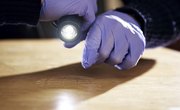The field of forensics is an increasingly important aspect of criminal investigations. The choices of topics for a research paper in this area cover a broad range of subjects with opportunities for an array of approaches. The research element of this type of paper is important, since developments are evolving every year, so make sure you get up-to-date information.
Automatism Defense
A controversial defense that relies on forensic investigations is automatism. Automatism is a state of consciousness in which a person is said to be committing a crime automatically, and should therefore be absolved of full or partial responsibility. The goal of the forensic investigation is determining whether this criminal behavior could have originated as an organic disease, such as a brain tumor or epilepsy, or if it resulted from another disorder, such as sleepwalking.
Facial Reconstruction
A vital forensic investigatory device in the cases of identifying suspects or victims many years after the crime has been committed is facial reconstruction. This tool uses clay and modeling tools to reconstruct facial features with only a skull for a model. Another method of facial reconstruction is computerized aging that can assist in finding adults who went missing when they were children. This topic is ripe for research into the specifics of how such forensic recreations are conducted, as well as discovering the reliability and usefulness of various techniques.
Determining Cause of Death
Forensic science, as applied to criminal investigations, is often tasked with finding cause of death. Research can uncover the history of determining the cause of death, as well as historic methodologies used to identify specific causes. Among those methods are looking for obstructions of the respiratory channels with liquid to indicate drowning, and tissue damage extensive enough to destroy the body’s vital functions to indicate poisoning.
Crime Scene Investigations
Forensic techniques that range from old and simple to current and sophisticated are used to examine the scene of the crime. Although the specifics and technology used have undergone significant changes, photographing the scene remains just as vital a forensic tool in the 21st century as it was in the 19th century. The collection of evidence, such as fingerprints and blood, have also improved, as have the methods of analyzing them. Collection of hair and fibers in forensic investigation at the scene of a crime has become more essential with advancements in microscopic technology and the introduction of forensic tools like chromatography and spectrometry. A paper on an investigative technique could also discuss emerging technology in that field.
Related Articles
References
Writer Bio
Timothy Sexton's more than 10,000 articles have been published on sites ranging from USA Today to CareerAddict, from PopEater to TakeLessons.com. His writing has been referenced in books ranging from "The Reckless Life...of Marlon Brando" to "Brand New China: Advertising, Media and Commercial and from Scarface Nation to Incentive!"











